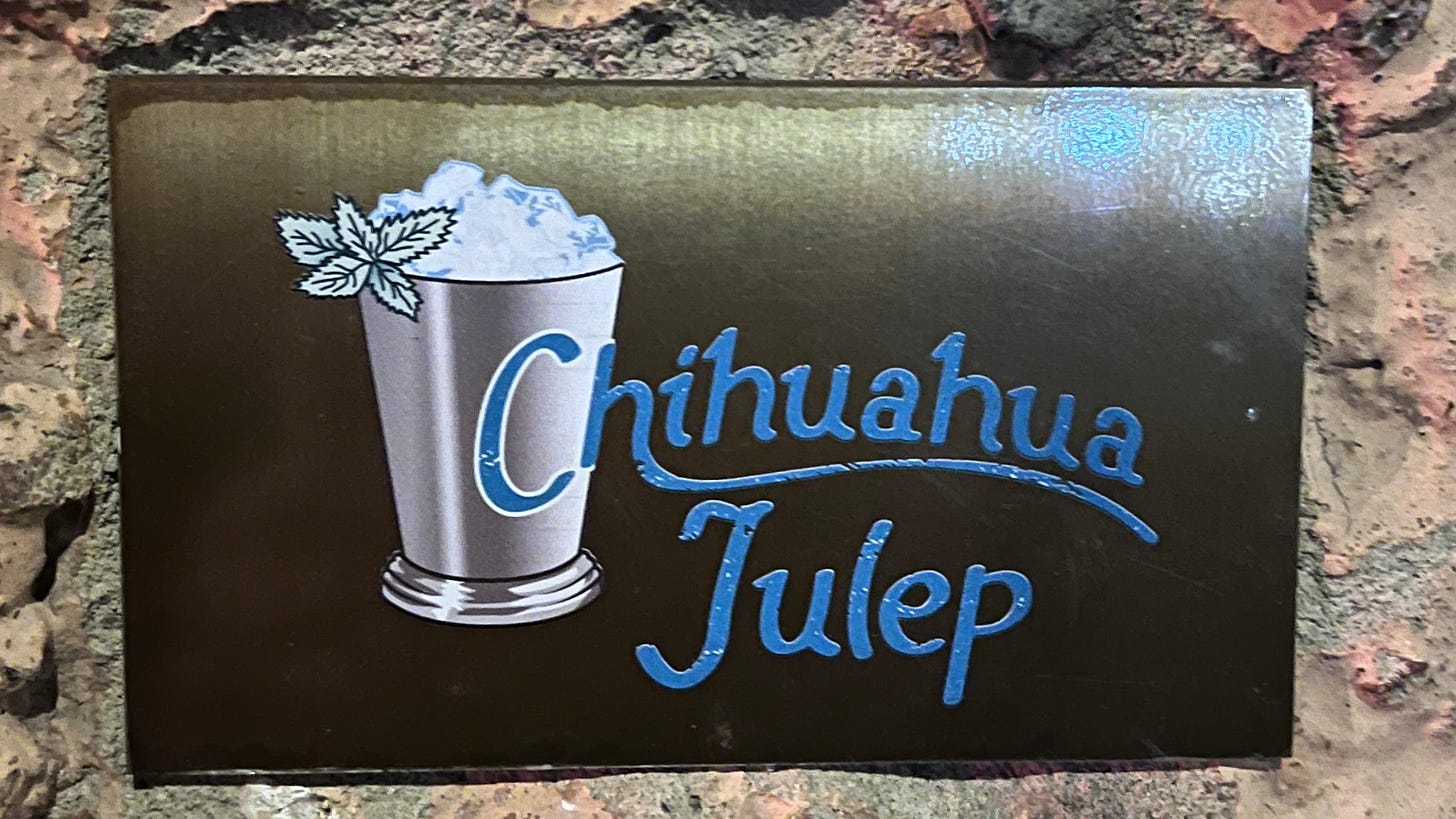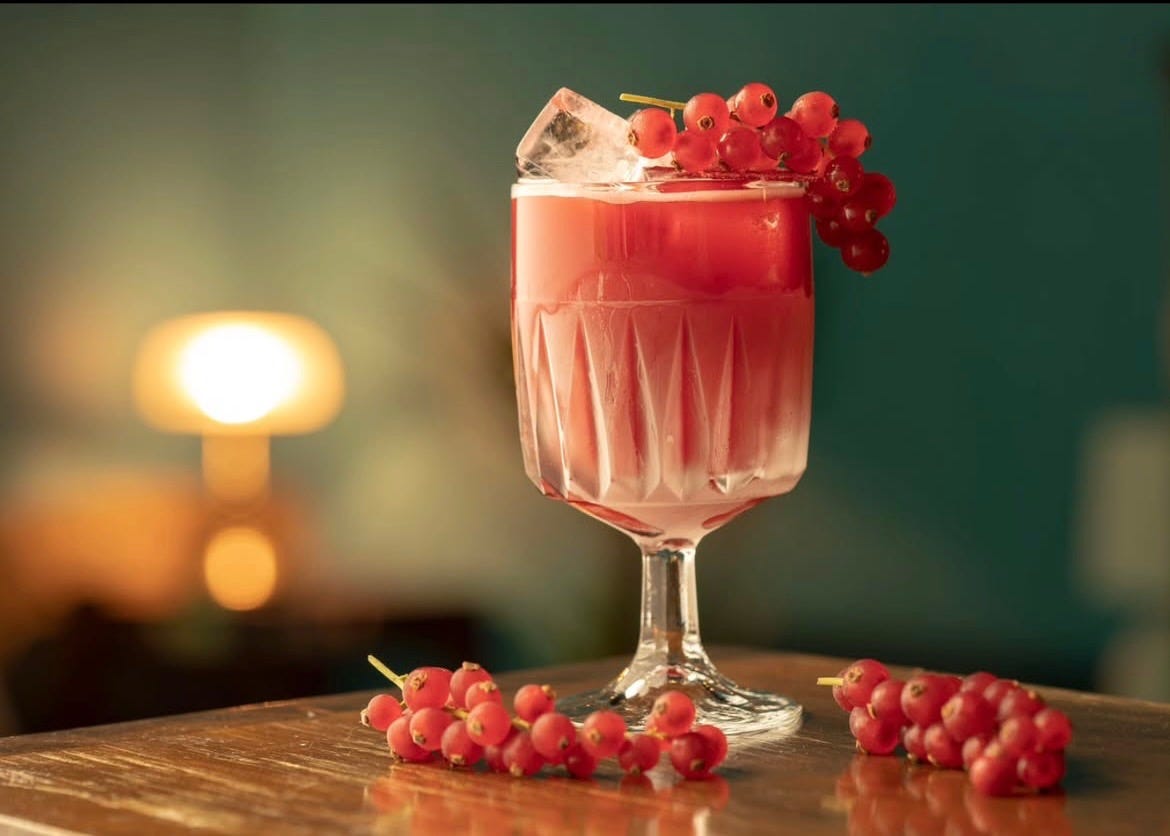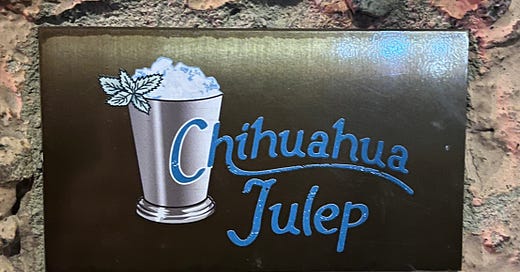I Can’t Tell You Much about Helsinki’s Most Charming Cocktail Bar
Phones are strictly prohibited inside—which means I have no photos and no notes from my visit. These are my jet-lag-fuzzed memories.

I’d known Chihuahua Julep’s primary rule before its owner greeted me at its door. “Is this your first visit?” he asked. “Do you know the rule?”
“It’s my first time, but yeah, no phones, I’ve heard,” I replied.
I like to take pretty photos of pretty cocktails. Inside this small cocktail bar, however, using a phone is strictly prohibited, so I wouldn’t be able to do that. In order to be seated, I agreed to abide by this condition.
He ushered me past the four tables in the Victorian-decorated front room—think mismatched velvet-upholstered loveseats—to one of the six bar stools up a few stairs in the back.
And thus began three hours of some of the most genuinely gracious hospitality I’ve ever received.
Unfortunately, I can’t relate as many details about it as I’d like. Because along with no photos of pretty drinks, no phone use, alas, also means no photos of the room, no photos of the menu to note drink ingredients, no photos of labels on unfamiliar bottles, no researching answers to questions that arose, no jotting down facts/ideas/impressions in my notes app, etc. (I no longer carry a notepad and pen with me, and the bar’s website is merely a landing page.) What were the names of the people I talked with? I have no idea. What was in any of the six drinks I tried or tasted? I remember some ingredients, but I’m sure I’ve forgotten others.
To make matters worse, I’d disembarked from a sleepless eight-hour overnight flight to Helsinki just four hours earlier, so my memory, unreliable even at the best of times, was essentially useless for recording any details. (And, to be honest, I’d had a couple of drinks earlier at Liberty or Death, a bar just a few storefronts down the street, which probably didn’t help matters.)
I started the evening with a drink called the Blue Velvet, an homage to what I would soon learn is a Finnish favorite flavor: bilberries, a close relation to blueberries; the Finns seem to use the words interchangeably. (A juice made from one or the other is served at hotel breakfasts and aboard the national airline—I encountered it everywhere during my trip to Finland and drank it at every opportunity.)
An elegant layering of blueberry flavors, the cocktail was made with pisco, bilberries, a locally produced rye-based bitter liqueur (which has been discontinued; the bar’s owner told me he had only a couple of bottles left), and a dessert wine made from blueberries, which the internet (god bless it) has reminded me is called Sametti.
He’d overheard me discussing it with my drinking companion. “Any questions?” he asked. “Ainoa Sametti,” I’d said, pointing at the menu. “Is that an amaro?” He poured me a small taste and explained that it was an award-winning Finnish blueberry wine.
Every drink comes with thoughtful tiny bites to accompany it, whether as an actual drink garnish or on the side. The blueberry cocktail was served with a small bowl of candies that resembled Sno-Caps but in fact had marzipan inside a nonpareil-covered chocolate shell. It was, somehow, the perfect accompaniment.
The pairings are “the hardest part of creating a cocktail,” the bartender said, “but they’re fun and good hospitality.” A flip that’s essentially liquid chocolate-raspberry cake comes with a tiny bowl of M&Ms. My dining companion got a bite-size canelé-like cake with his first drink. “In Finland, this cake is usually only served for celebrations,” we were told. “But here it’s a party every day.”

My second cocktail, the Noche de Rabanos, was presented in an elegant footed glass, topped with a sprig of red currants atop a square of fruit leather. “I am furious I can’t take a photo of this drink right now,” I said. “Look how pretty it is.”
“Buy a postcard,” my host suggested, and shrugged. He didn’t seem to be joking.
There were several moments over the course of my visit when both of the proprietors were elsewhere, when I could easily have snuck my phone out of my jacket pocket to snap a covert photo. I didn’t do so. I’d read reports online of guests being promptly kicked out for such actions. But more importantly, it would have felt disrespectful to my hosts, akin to insulting a meal that had been prepared for me.
Meanwhile, my drinking companion had ordered the Cucaracha Chihuahua, a drink with mezcal, tabac liqueur, lemon balm, and lemon. “Tabac liqueur?” I said, intrigued. A small pour of it was placed in front of me, a cognac-based tobacco-infused liqueur that seems to be made in France by a Louisiana-based company; sometimes you have to go abroad to know your own culture better, I suppose. The pairing for this drink, in my fuzzy memory, was a gouda-like cheese.
Since I didn’t have my nose buried in my phone, I turned my attention to scanning the compact back bar for other unfamiliar bottles, a favorite pastime at bars abroad. There weren’t as many as I usually encounter, and for good reason: The bar focuses on spirits from the Americas, which are less common in the Nordic countries. There’s a focus on agave spirits, as the bar’s name hints, but also plenty of American whiskeys, Cuban rums, etc.
I had plenty of time for such perusals. As the bar filled up, the wait for a drink got longer. A staff of two was working the night I was there: a 50ish-year-old married couple, whom I gathered were the bar’s owners. The man primarily stayed behind the bar and made drinks, while the woman primarily worked the floor, taking orders, but sometimes they swapped, or disappeared entirely.
How long, measured in minutes, might you be waiting for your next drink? There’s no way of knowing. Without a phone serving in place of a watch, and with no clocks visible, you suffer a casino-like loss of sense of time. Was it 10 minutes ago you ordered that cocktail? 15? 25? What is time, anyway?
I will say that my visit lasted two hours and 45 minutes, and I consumed three cocktails in that span of time, drinking at my usual rate; I would guess I spent as much time waiting for a drink as I did with one actually in front of me. If I’d been seated at a table, this might have been a source of frustration. At the bar, though, the reason for the lengthy wait is obvious.
The making of a cocktail here is a precise, lengthy process. The bartender will not be rushed. He measures carefully, stirs, tastes (dabbing a drop with a bar spoon on the back of his hand), stirs again, repeats, possibly repeats again. Places the drink on the bartop or a tray waiting nearby, then collects the pairing for it, moving deliberately. It’s a beautiful dance, and an elegant one, as much performance as it is precision.
I finished with a cocktail called Happiness, made with mezcal, lingonberries, hibiscus tea, and probably a few other things. It was a vivid rose color, garnished with a cocktail pick stacked with blueberries. I vaguely recall the menu referencing a honeymoon trip through Mexico as the drink’s inspiration, although I might well be getting that wrong.
“They say you cannot buy Happiness,” the bartender said as he placed the drink in front of me.
“And yet.” I replied, gesturing at it.
It was, again, a remarkably photogenic drink. It occurred to me, suddenly, that these beautiful drinks were being created for me, for my personal appreciation, rather than as a marketing tool to be photographed and widely shared. The realization made the entire experience seem more intimate, somehow: This performance, this beauty, was intended for me, the bar guest, personally, rather than for the world at large.
I don’t really remember a time of going out to bars without a smartphone. I recall an early-tech-adopter friend showing off his brand-new first-gen iPhone during my initial visit to PDT many (many, many) years ago. My personal cocktail-bar journey began in earnest, coincidentally, the same month I obtained my own first iPhone a couple years later. I barely recall what it was like to sit at a bar without scrolling, taking photos, taking notes.
As it turns out, it’s wonderful.
“What’s the reason for the no-phone rule?” I finally asked toward the end of my visit.
“There are societies that can handle constant access to small devices,” the bartender replied, making a scrolling motion with his hand. “Finns cannot.”
“It would have saved you from some of my endless questions,” I said. “I could have just looked up some of the answers.”
“Yes,” he said, smiling. “But instead we had an interaction.”



LOVED this so much — and I’ve always wished more bars could adopt this rule, but then the marketing paradox comes in.
Even regular guests, influencers, wannabe influencers will second guess patronizing if they can’t prove they were there for the ‘gram — but I think with the right PR strategy it could be done, and maintain a *really* special experience like yours was in Helsinki.
(My idea? Allow ONE photo, via Polaroid. It serves as a special memento / leave-behind, and the guest gets their photo, and they can even throw it up on IG.)
Thanks for the thorough story — I’m stoked to go one day! 👏😊
I can’t remember a thing without my phone.